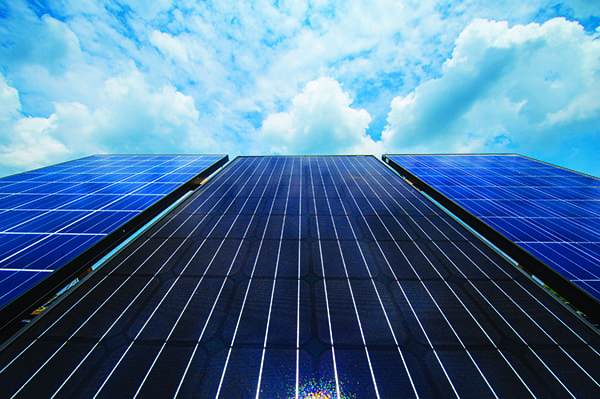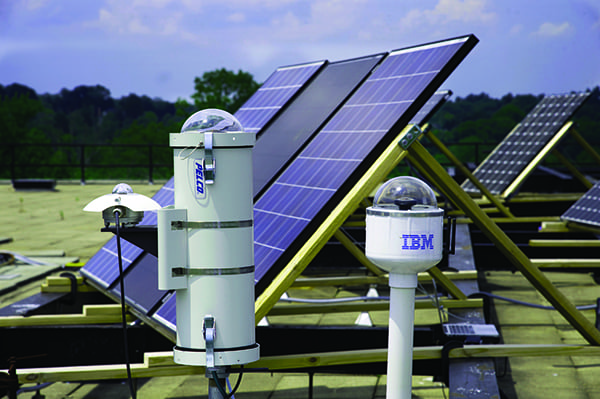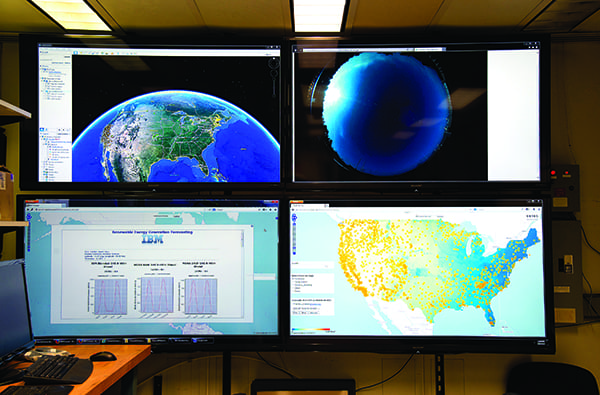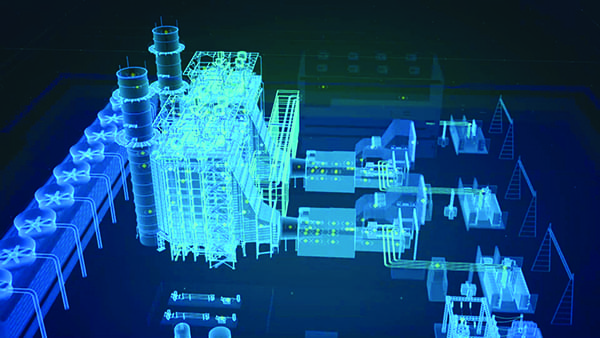Energy Generation from A-to-Z with Machine Learning
The human brain is an amazing thing, but it has limitations. However, with the advent of machine learning, the limitations of the human brain no longer have to be the limitations of civilization. Machine learning has been integrated into many aspects of human life, including the power sector, resulting in increased efficiency and ease of operation.
The term “machine learning” sounds like something out of a sci-fi novel, but in reality, this relatively new computer science, related to artificial intelligence, stands to improve human life by allowing progress on many fronts—including power generation—beyond what was thought possible just a few years ago.
Machine learning is a complex term. Boiled down, it refers to a type of artificial intelligence that allows computers to learn from data. As new data is presented, machine learning models and algorithms self-adapt.
“The very broadest definition of machine learning is using computers and algorithms to discover patterns within data,” Greg Mulholland, CEO of advanced materials and chemicals company Citrine Informatics, told POWER. More specifically, Mulholland continued, machine learning uses “relatively large-scale data” to find “highly complex” patterns.
Machine learning itself has been around for decades and is already being used in the energy sector in several ways, but there remains great opportunity for increased utilization for everything from materials optimization, advanced weather forecasting for solar and wind installations, and predictive operation of conventional power plants.
Better Materials, Better Operation
When it comes down to it, a product is only as good as the materials it’s made out of. Optimizing the makeup of a solar cell or battery is a long, complex process, a problem perfect for a machine learning solution.
“One of the big problems in the devices that are on the market today is, and this is true across everything—whether it’s a vehicle, or whether it’s a solar cell, or whether it’s a battery—is you’re typically asking the chemistry inside of those things to do multiple jobs at once, and a lot of [the] time those jobs are at odds with one another,” Mulholland said.
For example, he noted, the ideal car body would be light and strong, but typically strong materials are heavy, and light materials are weak. “The same thing is true in batteries, you want it to store a lot of power, but you want it to be safe, and you want it to recharge a lot of times, and you want it to be very effective over and over again. Same with solar cells, you want them to capture a lot of light, but you want them to get the energy out effectively,” he said.
Since its inception in 2009, Citrine Informatics has been working with customers to improve their existing products using machine learning, quicker than would be possible using traditional means. “We actually use machine learning to understand the underlying physics and chemistry about what’s going on in these devices, and help identify materials and chemistries that are going to push those devices in the right direction along many fronts,” Mulholland said.
Generally, Citrine isn’t setting goals for itself but helping customers reach their own goals in an expedited manner. “If you’re a solar cell company, you know what your next solar cell generation needs to look like. You understand your product right now,” Mulholland said. “Our products actually serve to accelerate your ability to achieve those milestones.”
Looking at a solar cell (Figure 1), Citrine’s machine learning models are able to ingest massive amounts of data, including the chemical formula of the materials in use in the cell, the processing history of that material, how the device is structured, and how the cell performs.
 |
| 1. It’s what’s inside that counts. The internal chemistry of solar cells is extremely complex, but can be optimized using machine learning. Courtesy: IBM |
All of that data is then analyzed. “We actually use machine learning to couple those together, to help identify, to look for patterns that say [for example] ‘when this particular crystal structure is there, you keep better performance,’ ” Mulholland explained.
According to Mulholland, using machine learning has allowed Citrine to help customers optimize their solar cells far faster than possible using conventional processes.
“It’s not so much that we’re trying to set a one-time record, we’re trying to use machine learning to actually allow the solar cell manufacturers to achieve their next generation solar cells in about half the time or less,” he said. “In the cases of solar cells we’ve worked in, it’s been about that. We’ve seen about a slightly greater than 50% acceleration, or 50% reduction, in the amount of time it’s taken to get through the development process for a particular class of materials.”
In short, machine learning enables Citrine to make products better, faster.
Better than a Weatherman
However, even operators of the best developed solar cells need to know as precisely as possible what sort of sun they’re going to get. That’s where IBM comes in. For the past few years, IBM has been working on advanced weather prediction using machine learning (Figure 2). “Renewable energy forecasting obviously has a lot to do with weather forecasting in general, because you need to predict how much sunshine and you need to predict how much wind,” Hendrik Hamann, senior manager and distinguished researcher in the physical sciences department at the IBM T.J. Watson Research Center, told POWER.
IBM’s self-learning weather model and renewable forecasting technology (SMT) uses machine learning, big data, and analytics to develop accurate solar forecasts. SMT analyzes numerous weather models while also taking into account which model has historically been most accurate in a given location under a given situation. So, if a high-pressure system is coming through a particular area in Wisconsin in early April, SMT will identify which model was most accurate last time a similar high-pressure system moved through that area of Wisconsin in April.
“We’ve actually used large-scale big data processing and machine learning to systematically learn the different strengths and weaknesses of these different prediction systems,” Hamann said “That information we use to do corrections to the existing weather models, or to create a blend out of all these models, to provide increased accuracy.”
Forecasts developed by the SMT can be used for solar, wind, and even hydropower generation. “In these particular [hydro] applications, especially longer term forecasts are actually of relevance. Sometimes we’re talking even about precipitation forecasts out to 30 days,” Hamann said.
SMT, unfortunately, suffers from some of the same obstacles as traditional weather forecasting. For example, some climates are just less predictable. In the U.S., Florida is a particularly challenging area. “This is a general problem known in weather forecasting. Tropical conditions are inherently difficult, so you cannot necessarily expect improvements,” according to Hamann. However, in areas near the center of the country, New England, and parts of the West coast, SMT has proven to be up to 50% more accurate than traditional forecasting (Figure 3).
IBM’s SMT program is funded in part by the Department of Energy’s (DOE’s) SunShot Initiative. While the future of the SunShot Initiative is murky, IBM continues to work closely with the DOE, waiting to see how the cards will fall.
SunShot was launched in 2011 during the Obama administration to try to drive down costs of solar energy. The program set goals for 2020 of $0.09/kWh for residential solar, $0.07/kWh for commercial solar, and $0.06/kWh for utility-scale solar. Additional 2030 goals were also set. The 2030 goals are $0.05/kWh for residential photovoltaics (PV), $0.04/kWh for commercial PV, and $0.03/kWh for utility-scale PV.
IBM also recently announced a partnership with ABB. ABB offers a digital solutions product called ABB Ability, which will be brought together with IBM’s Watson technology to “unlock new value for customers in utilities, industry and transport & infrastructure,” according to a press release issued on April 25.
One of the first efforts being pursued under the new collaboration will focus on smart grid optimization. “ABB and IBM will apply Watson’s capabilities to predict supply patterns in electricity generation and demand from historical and weather data, to help utilities optimize the operation and maintenance of today’s smart grids, which are facing the increased complexity created by the new balance of conventional as well as renewable power sources. Forecasts of temperature, sunshine and wind speed will be used to predict consumption demand, which will help utilities determine optimal load management as well as real-time pricing,” the release says.
New Tech, Traditional Generation
Renewables are not the only source of power generation getting a machine learning update. Laurent El Ghaoui, a professor of electrical engineering and computer science at the University of California, Berkeley (UC Berkeley), has developed a machine learning algorithm to help manage the operation of a cogeneration plant.
While renewables might be a tad “flashier” than traditional energy generation sources, traditional sources should not be ignored when exploring new machine learning processes (Figure 4). “You know, renewables, no matter how you slice or dice, it’s going to be a small part of tomorrow, medium-term, composition of energy,” El Ghaoui told POWER. “So I think working hard on the traditional sources and making them more efficient at least alleviates the brunt of the issue with energy.”
Working with UK-based EDF Energy, El Ghaoui has been working to perfect his algorithm for more than three years. The algorithm is not currently in commercial use, but it is being tested at an unnamed European cogeneration plant, which serves roughly 800 homes. Using machine learning El Ghaoui’s algorithm helps predict the future demand of the plant.
“It starts with a model and then tries to essentially take that model, which is an approximation of the reality, of course, and also make predictions about the demand for power and heat the next day,” El Ghaoui said.
The algorithm has proved to be significantly more accurate than human operators in its predictions. “Every hour it makes some bets, you would say, it’s like betting in a way, and it makes bets that are definitely more accurate in average. It doesn’t mean that the human on occasion cannot beat the machine,” he explained. “It’s just because it’s day-to-day, every hour, it’s consistently a little better, and in the end, it adds up quite a lot in terms of energy savings.” Because the plant runs more efficiently as a result of the increased accuracy of generation predictions, energy savings between 6% and 15% have been realized.
While it has only been used at a cogeneration plant, the algorithm would be applicable to many other generation types. “The focus is on cogen, but there’s nothing about cogen that is specific. In other words, what we do also applies to generation of hybrid energy, including nuclear, coal, hydroelectric,” El Ghaoui said.
Sometimes Machines Are Just Better
Shifting the energy industry to rely more heavily on machine learning and other forms of artificial intelligence can be a hard sell. For ages, the industry has been run on manpower and change is scary.
The industry is going to move forward, Mulholland, Hamann, and El Ghaoui all agreed, because the benefits of machine learning over reliance on humans are too great to deny much longer.
“Machine learning is always measured against what was being done before, and the reality is that in many fields the type of analysis that was being done before was largely driven by human intuition and human skill,” Mulholland said. “Machine learning does something much better than humans do and that is dealing with very, very, very large-scale data. The human brain is not built to look at data at an extremely large-scale.”
El Ghaoui agreed, comparing human plant operators to tired drivers who are unable to process everything going on around them on the road. “If you imagine the difference between two drivers, one is a little bit asleep and not very efficient and so on and so forth, and the other is really making sure and [paying] close attention to everything, definitely the most conscious driver, in the end, will beat the more distracted one. Not to say that humans are distracted, but it’s very hard for a human to capture all the complexity.”
According to El Ghaoui, developing machine learning programs is the easy part. Getting the programs put to use is where things get a bit more difficult. “The big challenge is not essentially the research or the algorithm because now there’s a level of maturity in all these machine learning algorithms and decision algorithms. … It’s not too complicated to put in place a model that on paper or in simulation that is really better. The big challenge, I think—and that touched upon the energy sector as a whole—is to go to implementation,” he said.
El Ghaoui noted that his team at UC Berkeley is “trying hard to implement [his algorithm] and push it to production, but it’s a complicated situation.”
Where to Next?
While the use of machine learning in the energy sector continues to grow, there remains a fair amount of low-hanging fruit for developers to pursue.
Although he advocates for the use of machine learning in traditional energy generation areas, El Ghaoui suggests that there is a great amount of potential for new machine learning processes in renewables. “I think there might be very good opportunities in renewables because what happens is that when there is a new system being designed, then [it is] much easier, because it’s the first time, so there are much [fewer] barriers, and so I expect the innovation along those lines might come from new plants,” he said.
Hamann suggested that the timing is perfect for the use of machine learning in the energy sector to accelerate even more. Massive amounts of data are being collected in nearly every area, from drilling to generation, grid operations, and so on. That data, in turn, can be used in machine learning applications.
“In general you have now, of course, much more instrumentation. We have the smart grid. Power plants are connected. There are people that have their own private weather stations. There’s a lot more instrumentation in oil and gas exploration. They use very complex measurements, every drill head is being instrumented, so you have all this data from these systems,” he noted.
“The next [questions are]: What do you do with that data and can you learn something from that data?” he said. “So now we can actually use machine learning techniques to learn systematically.” ■
—Abby L. Harvey is a POWER reporter.


